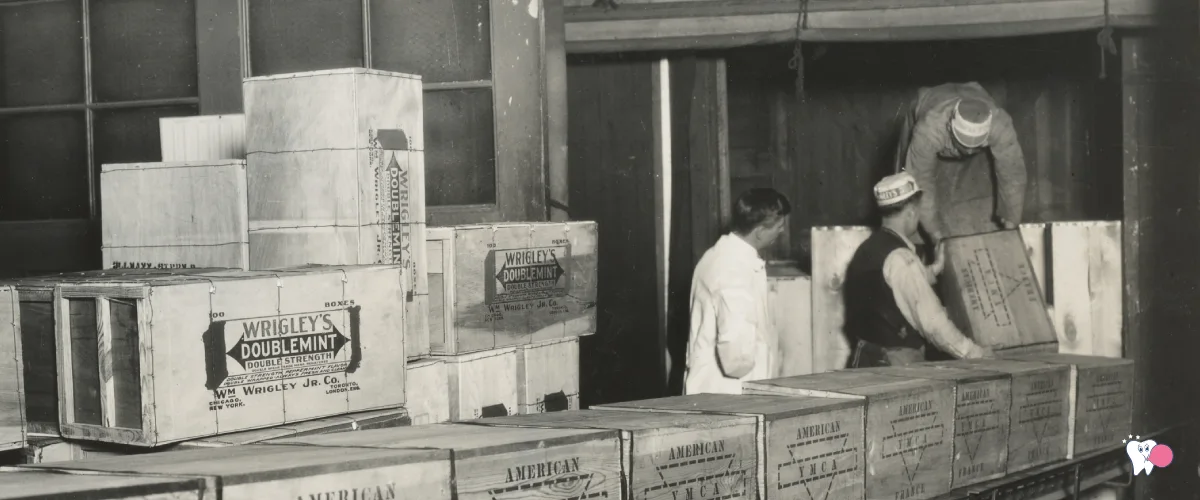Historical data of chewing gum (or timeline) – the first manufactured chewing gum, the first flavored gum, the first bubble gum, long-lasting gum, tutti-frutti, the first exploding gum, or sugar-free gum, dental gum.
19th century | 20th century | The period of World War II | The post-war period | 21st century | Today – healthy chewing gums
Historical data of chewing gum
Over 9,000 years ago – there is evidence that some Northern Europeans chewed birch bark tar.
9,000 years – 1840s – many nations chewed some precursors of gum directly from natural sources – ancient Mayans chewed a substance called chicle (from the sapodilla tree), Aztecs also used chicle.
19th century
1840s – in North America, Native Americans chewed spruce resin, a practice that continued with European settlers who followed them – perhaps like John Curtis.
1848 – first manufactured and sold chewing gum – John Curtis produced and sold the first commercial chewing gum called Maine Pure Spruce Gum.
1871 – first flavored gum (chewing gum) – Thomas Adams created gum with licorice flavor called “Black Jack”. The first gum with flavor. This contributed to the discovery of new chewing gum flavors.
1880 – John Colgan invented a way to extend the flavor of gum while chewing. It tasted better and lasted longer.
1881 – Thomas Adams patented a machine for chewing gum production. The machine sped up the production of multiple products.
1888 – Thomas Adams began selling the first gum in vending machines called Tutti-Frutti. The machines were placed in the New York subway station.
1892 – First marketing with chewing gums. Mr. Wrigley gave two packs of gum for free with baking powder. This marketing helped sell more products.
20th century
1906 – Frank Fleer invented the first pink bubble gum Blibber-Blubber. Allegedly, it was too sticky and easily burst.
1907 – American inventor Carleton Ellis first came up with the idea of nicotine gum (filed a patent). It’s the same person who invented margarine, polyester, and durable household paints. He proposed gum containing nicotine, intended for tobacco chewers – but his patent was not utilized enough to be put into production.
1928 – Walter Diemer improved Frank Fleer’s recipe by inventing a new pink-colored gum Double Bubble, which was also meant for bubble blowing (the so-called double bubble). The gum was less sticky, didn’t stick to the face, and still stretched more easily.
The period of World War II
1939-1945 – During World War II, there was a significant change in the production of chewing gum when, instead of natural gum base “chicle,” chemists developed a synthetic base. This was because the international sales of chewing gum had dramatically increased. Sapodilla trees, which produced chicle, began to suffer from excessive harvesting. Manufacturers had to develop an alternative that replaced natural chicle. This led to the development of synthetic gum base and new production methods that had lasting effects even after World War II.
1944 – A man from Pennsylvania lost several teeth while chewing when his experiment mysteriously exploded. This was apparently the beginning of the creation of exploding gum.
The post-war period
1950 – In the 1950s, consumers in America began to care more about their health. This led to the creation of sugar-free gum. The original idea reportedly belonged to dentist Dr. Petrulis. These “dentist-approved” gums contained ammonia (ammonium). This substance acted against acids that lead to tooth decay. Dr. Petrulis sold his company to gum giant William Wrigley Company. By the late 60s, they introduced the first sugar-free gum called Blammo. These gums are recommended by dentists and dental hygienists as part of dental hygiene. Healthy gums are recommended by dental chambers worldwide.
1951 – The Topps Company revived the popularity of gum by adding baseball cards to the package, replacing their previous gift of a single cigarette. Both children and parents liked it. This apparently led to adding other things to gums in the form of jokes, pictures, stickers.
1967 – Swedish chemical engineer Dr. Ove Fernö, who reportedly did not see Ellis’s patents, created a prototype that became a successful nicotine gum called NICORETTE. This happened 60 years after the patent was filed (1907) by American inventor Carleton Ellis, who proposed a gum containing nicotine [1]
1975 – The Finnish gum brand Jenkki introduced the first gum in the world that contained xylitol. Xylitol gum was invented in Turku, Finland. Xylitol was originally obtained from birches. Today, gums are available in many flavors, including peppermint, eucalyptus, lemon, tutti frutti, strawberry.
21st century
Current times – today there are hundreds of gum flavors, many types for medical purposes to gums that color our teeth. Gums are made from many different ingredients (ingredients in gums), such as pepsin, nicotine, etc.
Modern times – currently, many people are starting to think more about their health. That is, they think about the composition of the foods they consume. It has been found that some gum manufacturers use ingredients that should not be in gums and certainly not for children, who are the most common consumers of gums.
Today – healthy gums
Healthy gums – gums with better ingredients are starting to appear on the Czech market. They have existed for many years in America or generally in the Western world. It’s only up to the customer which path they take. Healthy gums are not just gums “for sunbathers” – these are sugar-free gums that do not contain controversial gum additives.

